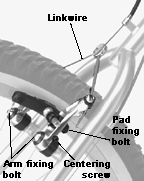
Figure 1:
Cantilever brake
With a cantilever brake system (Figure 1), the brakes are mounted directly to the frame, extending to the side. The brake lever is connected to the brake by a cable. By squeezing the lever, pressure is applied to the wheel rim by brake pads. This slows the rotation of the wheel, which slows the bicycle.
This system consists of several parts:
• Rim
• Brake lever
• Brake cable and housing
• Brake caliper
Never use rims designed specifically for disc brakes. Rim brakes require a flat sidewall on the rim for proper braking action.
The brake can easily be opened if needed.
Since the brake levers are part of this system, also read about brake levers on your bicycle:
· Brake levers for dropped, road bicycle handlebars
|
|
Figure 1: Cantilever brake |
|
|
Figure 2: Cantilever brake |
Before every ride squeeze the brake lever firmly. It should not be possible to pull the lever fully to the handlebar. When the brakes are not applied, the brake pads should be 1-2mm from the rim. Brake pads should be aligned with the rim surface (Figure 3). If your brakes are too tight, too loose, or not centered on the rim, adjust them before riding the bicycle.
Figure 3 shows toe-in, an angular alignment of the brake pad, which can be adjusted to prevent squealing of the brakes. Used brake pads, or some new direct-pull type brakes, may not require toe-in.
Every month check the brake cables on your bicycle for kinks,
rust, broken strands, and frayed ends, and check the housing for bent ends, cuts, stretched coils, and wear. Replace any part which does not pass inspection.
Every month inspect the brake pads on your bicycle for wear. Brake pads have shallow grooves in their braking surface. If any of these grooves are less than 2 mm deep, replace the pads.
Every 3 months tighten the bolts on the brakes to the torque specifications.
|
|
Figure 3: Brake pad alignment |
If your bicycle has flat-bar brake levers, adjust the barrel adjusters on the brake levers.
Otherwise, rotate the barrel adjusters found by following the brake cable away from the brake to where the cable enters the first piece of housing.
1. To loosen the pads, rotate the barrel adjuster counter-clockwise. To tighten the pads, rotate the barrel clockwise.
2. After adjusting, tighten the locknut to prevent the barrel adjuster from rotating.
1. Loosen the brake pad fixing bolt.
2. Follow the procedures in Inspection to align and tighten the brake pads.
3. After the brakes are adjusted, test the brakes.
Apply maximum braking force to the levers. Ensure the cable does not slip, the pads close toward the rim at right angles, and the pads do not contact the tire.
1. Rotate the centering screw (Figure 1). Turn in small increments and check for centering.
2. If the brake has two centering screws, adjust the overall spring tension while centering the brake
Installing a brake cable in a cantilever brake requires special tools and training, so should only be done by your dealer.
Every 3 months lubricate your brake arm fixing pivots with a light chain oil or a similar light oil.
Whenever a cable is replaced, lubricate the cable with a thin layer of synthetic bicycle grease or a similar lubricant.